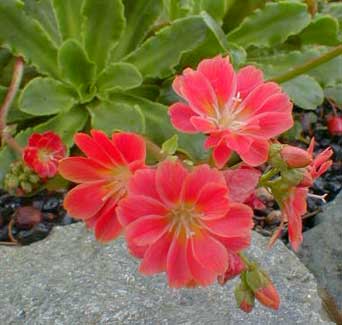 Sunset Red Cliff Maids
Sunset Red Cliff Maids
"Maids, not to you my mind doth change;
Men I defy, allure, estrange,
Prostrate, make bond or free:
Soft as the stream beneath the plane
To you I sing my love's refrain;
Between us is no thought of pain,
Peril, satiety."
-Michael Field
(Katherine Bradley, 1846-1914,
& Edith Cooper, 1862-1913)
(Katherine Bradley, 1846-1914,
& Edith Cooper, 1862-1913)
The Royal Horticultural Society gave the species L. cotyledon the Award of Garden Merit in 1993, the same year they awarded it separately to the Sunset Strain.
"Sunset Strain" or "Sunset Hybrids" constitute a cluster of lewisias rather than a single cultivar, & can be found in a variety of flower colors, from ivory to yellow to dark pink or orange to cherry red. The one shown here is Sunset Red in April. It's a large vigorous clump of leaf-rosettes producing hundreds of flowers through a long season.
The strain originated with the late Jake Drake of the Inshriach Alpine Plant Nursery nestled in the Cairngorm Mountains of the Highlands of Scotland. The strain has become widely available by seeds through the German company Jelitto. Several specialty growers produce the strain, a few of whom have used it as the basis of select strains of their own.
One of our other "Sunset" Bitterroots has longer than average succulent spoon-shaped leaves forming a nearly perfect, tidy, partially upright rosette. Being a hybrid, the leaf appearance of seed-grown specimens is no more predictable than the flower color. Growing right next to this long spoon-leafed specimen is a second "Sunset" & that one has shorter, fatter, pointier, wrinkly leaves, showing nothing in common with its sibling. The "Sunset Red" shown here has medium-sized narrow wrinkled leaves distinct from those other two. That each plant has quite a different leaf as well as a different color is expected of seed-grown hybrids. A gardener can only be sure of a specimen being of the Sunset cluster of lewisias because a label says so; nothing about them makes them identifiable once they are separated from their tags.
The usual bloom time for the lewisias is May & June, but some some start sooner, including "Sunset," with rebloom around September. Although they can self-seed, such a mild temperate climate as ours is not cold enough in winter for the seeds to germinate, thus seedlings rarely erupt without assistance.
To grow them from seed requires that the seeds be collected & started off in very specific conditions. Typically they are sewn in warm moist soil (in the range of 65 to 72 degrees Fahrenheight), but soonafter brought down to winter temperatures in the vicinity of 25 to 35 degrees Fahrenheight, which must be sustained for four to six weeks. The germinated seed can then be field-planted or put out in coldframes, but when the temperature is permitted to rise, it should at first duplicate spring conditions by remaining in the vicinity of 45 or 50 degrees F., give or take. It'll be a nice little plant in approximately two months.
Duplicating the seasonal thermic cycle is essential to get the plant started, after which it is never again so necessary to narrowly duplicate seasonal temperatures for them, as the plant is surprisingly adaptable. They are fussy only during the germination process.
Cliff Maidens require little or no fertilizing. At most a very deluted evergreen fertilizer low in nitrogen will do, & really, a thin topcoating of leafmold or steer manure once a year keeps the soil good for them.
Lewisia cotyledon Sunset Pink